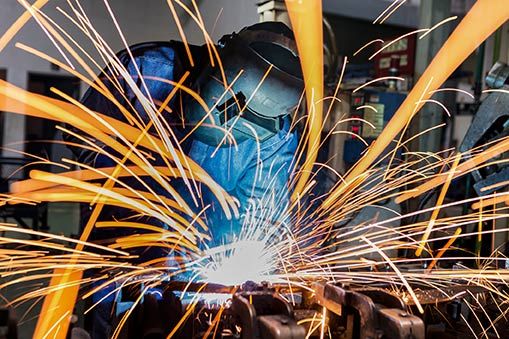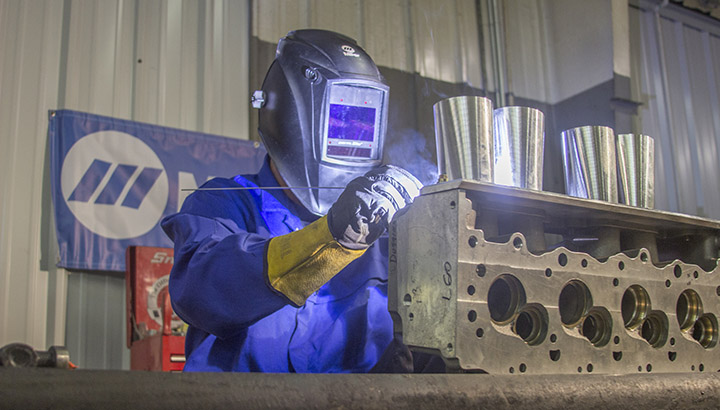Typical Welding Repair Issues and Exactly How to Address Them Effectively
Welding repairs commonly experience a variety of problems that can threaten the honesty of the last item. Usual troubles consist of poor infiltration, porosity, and imbalance, amongst others. Each problem offers unique challenges that call for details strategies for resolution. Comprehending these concerns is necessary for welders intending to improve their results and abilities. This discussion will check out these common welding fixing issues and reliable techniques to resolve them.
Poor Penetration
Inadequate penetration takes place when the weld metal stops working to fully fuse with the base material, resulting in weak joints and potential architectural failings. This issue typically originates from insufficient warmth input, inaccurate electrode angle, or incorrect welding rate. Welders might encounter poor infiltration as a result of a miscalculation of the essential specifications for a details material density or type. In addition, contamination on the base material's surface area can hinder reliable bonding, exacerbating the problem. To resolve poor infiltration, welders ought to assure suitable setups on their tools and preserve a tidy job surface. Routine inspection of welds is recommended to identify any type of shortages early, permitting timely improvements and the prevention of jeopardized structural stability in bonded assemblies.
Porosity
Porosity is a common flaw in bonded joints that materializes as tiny gas bubbles caught within the weld metal. This defect can jeopardize the honesty of the weld, resulting in lowered strength and prospective failing under tension. Belgrade Welding. Porosity typically occurs from contamination, wetness, or incorrect welding strategies, which permit gases to run away into the liquified weld swimming pool. To attend to porosity, welders need to ensure appropriate surface area preparation, preserve a tidy workplace, and utilize appropriate welding specifications. Furthermore, choosing the ideal filler product and securing gas can mitigate gas entrapment. Normal evaluation and testing of welds can help determine porosity early, guaranteeing prompt corrective actions are taken, thereby preserving the quality and reliability of the bonded framework
Imbalance
Misalignment in welding can develop from different elements, including inappropriate configuration and thermal development. Comprehending the origin causes is essential for effective resolution. Several adjustment strategies are offered to realign components and ensure architectural honesty.
Sources of Misalignment
Welding imbalance usually comes from a range of underlying issues that can jeopardize structural stability. One key reason is improper fit-up of parts before welding, which can result in gaps and unequal surface areas. Variations in thermal growth during the welding process can likewise lead to distortion, especially if the products being joined have various coefficients of growth. In addition, insufficient fixturing and securing may fail to hold elements securely in location, causing movement throughout welding. Poorly conserved devices, including welding machines and devices, may present incongruities in the weld grain, further adding to imbalance. Finally, driver error, originating from insufficient training or experience, can additionally play a significant duty in producing misaligned welds.
Improvement Strategies Readily Available
Addressing imbalance efficiently needs a combination of corrective techniques tailored to the specific concerns available. One usual approach is making use of jigs or components to hold elements in the correct setting during welding, ensuring constant placement. Furthermore, pre-heating the materials can assist decrease distortion and enhance fit-up. For substantial imbalance, mechanical adjustment techniques, such as making use of hydraulic jacks or clamps, can be utilized to correct the position prior to welding. Post-weld heat treatment may likewise be necessary to soothe stresses brought on by imbalance. Mindful assessment and adjustment during the configuration stage can protect against imbalance problems from becoming substantial troubles, promoting a smoother welding procedure and boosting total structural stability.
Distortion
Distortion is an usual obstacle in welding that can occur from various factors, including uneven cooling and heating. Recognizing the sources of distortion is necessary for carrying out efficient avoidance techniques. Resolving this issue not just improves architectural stability but also boosts the total top quality of the weld.
Reasons of Distortion
When subjected to the intense warmth of welding, products typically undertake modifications that can lead to distortion. This sensation largely develops from thermal development and tightening during the welding procedure. As the weld area heats up, the product expands; upon cooling, it contracts, which can produce interior anxieties. Additionally, uneven heating throughout a work surface can intensify these stress and anxieties, leading to warping or bending. The sort of material also plays a significant role; steels with differing thermal conductivity and coefficients of growth might react get redirected here differently, resulting in unforeseeable distortions. In addition, poor joint design and poor fixturing can add to imbalance during welding, boosting the possibility of distortion. Comprehending these causes is vital for reliable welding repair service and avoidance methods.
Avoidance Techniques
Efficient avoidance methods for distortion throughout welding emphasis on controlling heat input and ensuring proper joint design. Keeping a consistent warm input helps to decrease thermal expansion and contraction, which can cause distortion. Using strategies such as preheating the work surface can likewise reduce the temperature level slope, advertising consistent heating. In addition, choosing proper joint layouts, such as T-joints or lap joints, can enhance stability and minimize stress and anxiety concentrations. Executing correct fixturing to safeguard the workpieces in place better help in maintaining positioning during the welding process. Staggered welding sequences can disperse warm a lot more evenly, avoiding localized distortion. By applying these methods, welders can considerably lower the possibility of distortion and boost the total quality of their welds.
Splitting
Cracking is a common concern encountered in welding repairs, typically resulting from different aspects such as improper cooling rates, material option, or insufficient joint prep work. The event of splits can considerably jeopardize the integrity of the weld, resulting in potential failings during procedure. To address this issue, welders need to initially assess the root triggers, making certain that products are compatible and appropriately chosen for the details application. In addition, regulating the air conditioning price during the welding process is essential; rapid air conditioning can cause anxiety and bring about cracking. Appropriate joint style and preparation likewise contribute to reducing the danger. Carrying out these approaches can enhance weld top quality and sturdiness, inevitably lowering the likelihood of cracking in finished weldments.

Incomplete Fusion
A significant concern in welding repair work is insufficient combination, which occurs when the weld metal does not appropriately bond with the base product or previous weld passes - Montana Mobile Welding and Repair Welding. This issue can result in weak points in the joint, possibly jeopardizing the honesty of the bonded framework. Aspects adding to incomplete fusion include not enough warmth input, inappropriate welding method, and contamination of the surface areas being joined. To address this problem effectively, welders should ensure correct pre-weld cleansing and surface area prep work, in addition to change their welding criteria to accomplish adequate infiltration and combination. Regular evaluation throughout the welding procedure can additionally aid identify incomplete blend early, permitting for prompt corrective steps to boost the total quality of the weld
Overheating
While welding repair services can enhance architectural stability, overheating offers a considerable obstacle that can lead to material destruction. Too much warm throughout welding can modify the mechanical residential or commercial properties of steels, resulting in decreased strength, boosted brittleness, and warping. This sensation is particularly vital in high-stress applications where structural integrity is vital. Identifying getting too hot can involve visual assessments for discoloration or distortion, along with keeping track of temperature during the welding process. welding for beginners To minimize the threats related to getting too hot, welders should employ suitable methods, such as regulating warm input, readjusting travel rate, and using ideal filler materials. In addition, carrying out pre- and post-weld heat treatments can help restore material residential properties and boost the general top quality of the repair, making sure long-term efficiency and security.
Often Asked Questions
What Are the Typical Signs of a Welding Flaw?

Exactly How Can I Check My Welds for High quality?
To examine welds for quality, one can make use of visual assessments, ultrasonic testing, and radiographic methods. Each strategy guarantees structural integrity, identifies defects, and verifies adherence to defined requirements, ultimately boosting the integrity of the bonded joints.
What Security Safety Measures Should I Take While Welding?
When welding, one ought to prioritize safety by using appropriate individual safety equipment, guaranteeing correct air flow, securing flammable products away, maintaining a clean work space, and being conscious of environments to stop injuries and crashes.
Can I Fix a Weld Without Redoing the Entire Joint?
Fixing a weld without redesigning the entire joint is feasible, relying on the damage (Montana Mobile Welding and Repair Belgrade). Strategies such as grinding, including filler product, or making use of a welding procedure can successfully attend to specific defects while preserving the bordering structure
What Tools Are Necessary for Efficient Welding Repair Works?
Crucial go to this website tools for reliable welding repairs include a welding machine, cable brush, mill, protective equipment, clamps, and filler products. Each device plays an essential function in ensuring top quality and safety throughout the fixing process. Porosity generally develops from contamination, moisture, or improper welding strategies, which permit gases to leave right into the molten weld swimming pool. Improperly maintained equipment, including welding devices and devices, may present variances in the weld bead, additional adding to misalignment. When subjected to the extreme heat of welding, products frequently undergo modifications that can lead to distortion. Breaking is a typical problem encountered in welding repairs, commonly resulting from numerous factors such as incorrect air conditioning rates, material choice, or poor joint preparation. A significant issue in welding repair services is insufficient blend, which occurs when the weld metal does not sufficiently bond with the base product or previous weld passes.